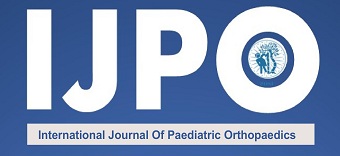Hip Displacement in Children with Cerebral Palsy- A Clinico- Radiological Evaluation
Volume 10 | Issue 3 | September-December 2024 | Page: 6-11 | Deepa Metgud, Shruti Desai, Shreya Bavi, Vinuta Deshpande, Naveenkumar Patil, Santosh Patil
DOI- https://doi.org/10.13107/ijpo.2024.v10.i03.200
Open Access License: CC BY-NC 4.0
Copyright Statement: Copyright © 2024; The Author(s).
Submitted: 20/11/2024; Reviewed: 26/11/2024; Accepted: 08/12/2024; Published: 10/12/2024
Authors: Deepa Metgud PhD, MPT [1], Shruti Desai MPT [1], Shreya Bavi MPT [1], Vinuta Deshpande MPT [1], Naveenkumar Patil MS Ortho [2], Santosh Patil MD Rad [3]
[1] Department of Paediatric Physiotherapy, KAHER Institute of Physiotherapy, Belagavi, Karnataka, India.
[2] Department of Orthopaedics, KAHER’S JGMM Medical College Gabbur, Kotagondhunshi, Hubbali, Karnataka, India.
[3] Department of Radiology, JN Medical College, Belagavi, Karnataka, India.
Address of Correspondence
Dr. Deepa Metgud
Department of Paediatric Physiotherapy, KAHER Institute of Physiotherapy, Belagavi, Karnataka, India.
Email Id: deepametgud@klekipt.edu.in
Abstract
Background: Children with cerebral palsy (CP) are at risk for hip subluxation due to the spasticity and contractures of the hip adductors, medial hamstrings, and hip flexors. Hip displacement is often asymptomatic in these children until the hip is particularly or fully dislocated resulting in pain, gait disturbances and impaired sitting balance. Hip surveillance is a process of actively monitoring a child for early identification of hip displacement. In India, the National Hip Surveillance Program was established to support surveillance in preventing dislocations and reducing the need for surgery. In light of this, the present study aims to determine the prevalence of hip displacement in children with cerebral palsy in Belagavi.
Method: This descriptive, cross-sectional observational study was conducted at a tertiary care hospital and inclusive education schools. Children aged 2–18 years with cerebral palsy, underwent clinical examinations followed by radiographic evaluation and the Migration Percentage (MP) was calculated to categorize hip displacement, the primary outcome measure of the study. Prevalence of subluxation and its association with gender, age, GMFCS E&R levels and CP subtypes were assessed.
Results: Out of 128 children with CP assessed, 104 had subluxation, with the majority (73.44%) showing bilateral involvement, while 7.81% had right-sided subluxation. The prevalence of subluxation varied by CP subtypes, with spastic type accounting for the higher prevalence. A statistically significant association between CP subtype and subluxation was found on the right side (p = 0.003).
Conclusion: The study identifies an 81.3% occurrence of hip subluxation in children with CP, with bilateral involvement being the most prevalent (73.44%). The likelihood of subluxation was notably impacted by CP subtype, especially in spastic CP. Timely detection through clinical assessment and radiographic monitoring is vital to prevent advancement to dislocation. Future investigations should prioritize extended follow-ups and therapeutic approaches to optimize outcomes.
Keywords: Hip subluxation, Cerebral palsy, Radiography, Migration percentage
References
1. Kammar S, Varma A, Paul S, Pillai I. Hips in cerebral palsy: A clinico-radiological evaluation of hip subluxation in cerebral palsy. Journal of Clinical Orthopaedics and Trauma. 2023 Aug 1;43:102224.
2. Kamate M, Detroja M. Which is the most common physiologic type of cerebral palsy?. Neurology India. 2022 May 1;70(3):1048-51.
3. Chand S, Aroojis A, Pandey RA, Johari AN. The incidence, diagnosis, and treatment practices of developmental dysplasia of hip (DDH) in India: A scoping systematic review. Indian Journal of Orthopaedics. 2021 Sep 24:1-2.
4. Kammar S, Kalluraya S, Paul S, Varma A. Prevalence of Hip Subluxation/Dislocation In Children with Cerebral Palsy in Relation to Severity and Type of Cerebral Palsy. Int J Acad Med Pharm. 2023;5(4):547-52.
5. Howard JJ, Willoughby K, Thomason P, Shore BJ, Graham K, Rutz E. Hip surveillance and management of hip displacement in children with cerebral palsy: clinical and ethical dilemmas. Journal of Clinical Medicine. 2023 Feb 19;12(4):1651.
6. Graham HK, Rosenbaum P, Paneth N, Dan B, Lin JP, Damiano DL, Becher JG, Gaebler-Spira D, Colver A, Reddihough DS, Crompton KE, Lieber RL. Cerebral palsy. Nat Rev Dis Primers. 2016 Jan 7; 2:15082. doi: 10.1038/nrdp.2015.82. PMID: 27188686; PMCID: PMC9619297.
7. Wang L, Zhang N, Fang L, Cui Z, Niu H, Lv F, Hu D, Wu D. Effect of hip CPM on gross motor function and development of the hip joint: a single-center randomized controlled study on spastic cerebral palsy children with hip dysplasia. Frontiers in Pediatrics. 2023 May 9;11:1090919.
8. Wynter M, Gibson N, Willoughby KL, Love S, Kentish M, Thomason P, Graham HK, National Hip Surveillance Working Group. Australian hip surveillance guidelines for children with cerebral palsy: 5‐year review. Developmental Medicine & Child Neurology. 2015 Sep;57(9):808-20.
9. Aroojis A, Jerbai B. Indian Hip Surveillance Guidelines for Children with Cerebral Palsy.
10. Connelly A, Flett P, Graham HK, Oates J. Hip surveillance in Tasmanian children with cerebral palsy. Journal of paediatrics and child health. 2009 Jul;45(7‐8):437-43.
11. Larnert P, Risto O, Hägglund G, Wagner P. Hip displacement in relation to age and gross motor function in children with cerebral palsy. Journal of children’s orthopaedics. 2014 Mar;8(2):129-34.
12. Pruszczynski B, Sees J, Miller F. Risk factors for hip displacement in children with cerebral palsy: systematic review. Journal of Pediatric Orthopaedics. 2016 Dec 1;36(8):829-33.
13. Gamble JG, Rinsky LA, Bleck EE. Established hip dislocations in children with cerebral palsy. Clinical Orthopaedics and Related Research (1976-2007). 1990 Apr 1;253:90-9.
14. Kentish M, Wynter M, Snape N, Boyd R. Five-year outcome of state-wide hip surveillance of children and adolescents with cerebral palsy. Journal of pediatric rehabilitation medicine. 2011 Jan 1;4(3):205-17.
15. Picciolini O, Albisetti W, Cozzaglio M, Spreafico F, Mosca F, Gasparroni V. “Postural Management” to prevent hip dislocation in children with cerebral palsy. Hip International. 2009 Jan;19(6_suppl):56-62.
| How to Cite this Article: Metgud D, Desai S, Bavi S, Deshpande V, Patil N, Patil S | Hip Displacement in Children with Cerebral Palsy – A Clinico- Radiological Evaluation | International Journal of Paediatric Orthopaedics | September-December 2024; 10(3): 6-11. |

